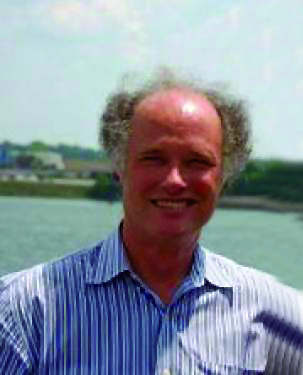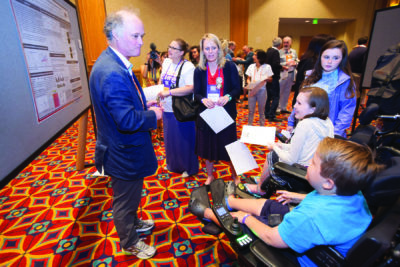On the 25th anniversary of the SMA Researcher Meeting, we would like you to learn more about Dr. Burghes and his commitment to the Cure SMA community.

Arthur Burghes, Ph.D., is a Professor of Biological Chemistry and Pharmacology at The Ohio State University and an internationally recognized research scientist who has dedicated more than 30 years to researching and understanding spinal muscular atrophy (SMA). What many in the SMA community do not know is that he has played a pivotal role in the development and continuation of the annual SMA Researcher Meeting for more than two decades.
SMA piqued Dr. Burghes’ interest early on. It all began in the 1980s when he was doing his graduate work in Hammersmith Hospital in London. “The unit was being run by Dr. Victor Dubowitz, who had been studying neuromuscular diseases for ages,” he shared. Dr. Burghes was working on the genetics of Duchenne muscular dystrophy (DMD) and often saw SMA patients when he visited the clinic. “It didn’t seem like anybody was working on it, so I began to look at what SMA was,” said Dr. Burghes. At that time, little was known about the genetics of SMA, or really SMA in general.
After Dr. Burghes finished his Ph.D. in 1984, he completed a postdoc in the Hospital for Sick Children in Toronto, working in Dr. Ron Worton’s lab during the race to clone the DMD gene. In 1988, he was hired by Dr. Jerry Mendel and began a faculty position at The Ohio State University. He then had the opportunity to work on finding the gene for SMA. “The gene that caused SMA was unknown and there were so many opportunities to learn more,” he shared. He started collecting DNA samples from SMA patients in 1988 to begin mapping the position of the SMA gene in the genome.
In the 1990s, Dr. Burghes was invited by Audrey Lewis, the founder of then Families of SMA (now Cure SMA) to attend its meeting of families of children with SMA, along with Dr. P. Michael Conneally, who ran the patient registry, and Dr. T. Conrad Gilliam, who was also mapping the SMA gene. “At that time, the meetings to discuss SMA focused solely on the genetic mapping and cloning of the gene, and thus tended to be confined to genetic meetings.”

After the gene was cloned in 1996, there was a need to involve researchers and physicians from many different disciplines to identify potential therapies for SMA. Dr. Burghes knew it was pivotal to include geneticists, clinicians, biochemists, and pharmaceutical companies together. And so, the group expanded. “It became important to exchange information amongst everyone. One of the first bigger North American meetings was in 1997 with 12 people, and then it grew a bit more and was officially named the North American Families of SMA meeting.” This was first discussed with Audrey Lewis, who agreed and had the vision to expand the meeting beyond just families impacted by SMA.
Soon, the meeting became International. “We created a unique atmosphere. You have all the researchers around in the room. Back then, there weren’t that many of us, but the discussions were vibrant.” He continued by stating how important it is to have disagreements in these meetings. “You can agree to disagree. You can encourage an atmosphere that explores what those differences are and answers the questions. Families of children with SMA wanted answers to the questions.”
The SMA Researcher Meeting was unique in that it was simultaneous with the Annual SMA Conference for individuals with SMA and their families. This unusual meeting environment resulted in direct interaction between researchers, physicians, patients, and their families. “It has often been said by researchers that the SMA meetings were the most inspirational meeting they had ever been to. There is no better motivation to study SMA and find therapies to meet the needs of SMA patients and their families.”
Dr. Burghes has only missed one of the 25 Annual SMA Conferences, which fell on the same weekend as his son’s graduation. As he reflects on his past 25 years, Dr. Burghes shared that one of his favorite Conference memories was a wheelchair ice hockey game where researchers powered the patient’s chairs. Of course, the long-held tradition of a wheelchair race between researchers and people with SMA is one of Dr. Burghes favorite activities. “It is so much fun and the current record for researchers is 0 wins.” Dr. Burghes enjoys meeting families and connecting with the community most of all.
“On the 25th anniversary of the SMA Researcher Meeting, we would like to share our gratitude to Dr. Burghes, said Dr. Jill Jarecki, Chief Scientific Officer at Cure SMA. “He was instrumental in launching this important meeting in its early years and remains committed to ensuring its success year-after-year. Moreover, his long-term support of Cure SMA, as well as his enduring and seminal scientific contributions to SMA, have helped lead the way in our understanding and treatment of SMA.”
On behalf of everyone in the SMA community, Cure SMA would like to say “thank you” to Dr. Burghes!
Dr. Burghes Advice to New SMA Researchers:
“First, be confident and tackle a real problem that exists. Follow your data. Do the experiments and let the data tell you what is going on. Don’t have a closed mind if your data doesn’t agree with what your hypothesis is. Don’t become too embedded in the story. Make sure you follow the data and what the data says. It’s very likely to be successful if you continue by that line, so don’t be frightened by contrary results and don’t be frightened of following them. There are still many questions in the SMA field that need to be answered.”



